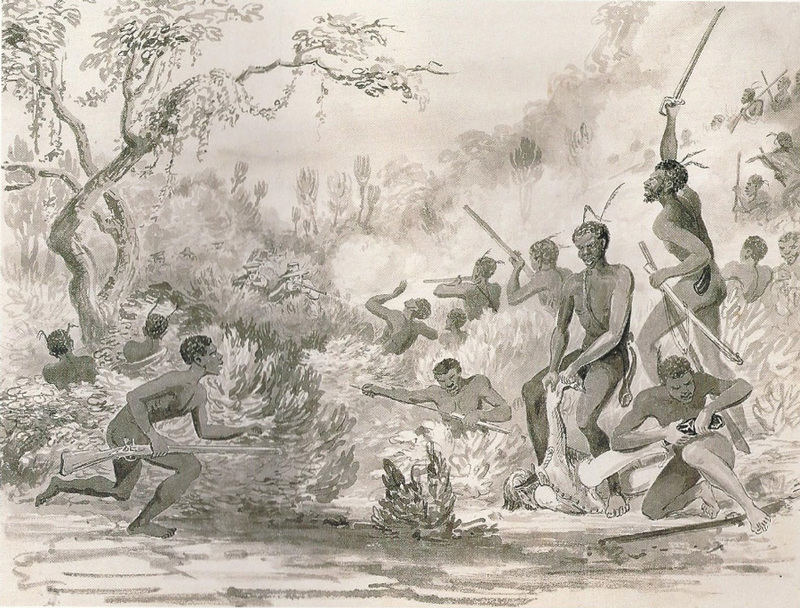Charles Davidson Bell

Housed in the University of Cape Town’s Special Collections are the paintings of Charles Davidson Bell (1813 – 1882). This collection is the property of The John and Charles Bell Heritage Trust, which was established in 1975 by Professor Charles Manning, a grandson of Charles Davidson Bell by his second wife, Helena Krynauw.
Charles Davidson Bell, energetic and alert, blessed with an enquiring mind, an ebullient sense of humour and a prodigious artistic talent, was two months short of his seventeenth birthday when he first stepped onto the shores of Table Bay in the spring of 1830. - The Life and Work of Charles Bell by Phillida Brooke Simons, page 15
A versatile and talented artist, Charles Bell also mastered the art of wood-carving and wood-engraving
Charles Bell was born in Scotland in 1813, and arrived at the Cape in 1830 at the invitation of his uncle, Colonel John Bell, who was the Colonial Secretary of the Cape at the time. During his early years in Cape Town, he was introduced to Cape society by his uncle, and began sketching local scenes around the peninsula. Typical of his Cape Town scenes is the watercolour shown below, which captures a group of ‘Cape Malays’ as they were called, under an umbrella selling carbonatjies, a favourite ‘Malay’ dish consisting of small mutton steaks grilled over red-hot coals.
A big milestone in his life was being chosen, at the age of twenty-one, to accompany an expedition under Dr Andrew Smith into the interior. He was entrusted with keeping a pictorial diary of the African landscape and of the indigenous people that they would encounter. The expedition travelled via Kuruman, where there was a mission station, to its objective, the Tropic of Capricorn, in modern day Botswana.
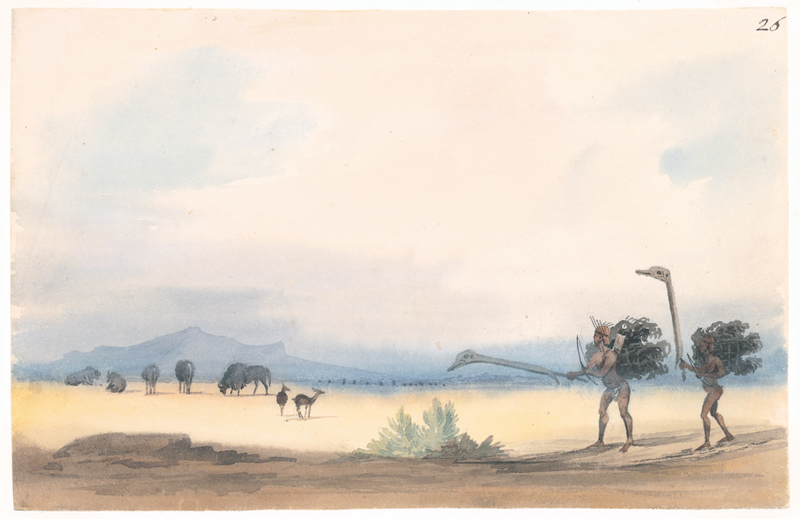
Bushman - Another Method
One of Bell’s sketches from the Smith expedition to the Tropic of Capricorn.
Bell pursued a career in the civil service, qualifying as a land surveyor at the age of twenty-four. One of his first tasks was to resolve land disputes in Namaqualand, which necessitated another long journey into the interior, in 1840 and 1841. He used this as an opportunity to sketch life in Namaqualand at that time. The painting shown here depicts a matjieshuis consisting of overlapping rush mats sewn together with bark threads made by the Korana people.

A year later, by now recently married, Bell was again entrusted with the settlement of a land dispute far from home, this time in the Eastern Cape. He was to remain there for two years before returning to the comfort of Cape Town. The sketch below, executed at around this time shows a rather dramatic portrayal of a mail coach travelling at break-neck speed down a treacherous pass.
In 1846 the Seventh Frontier War broke out, and although Bell was not there to witness any of the fighting, he nevertheless produced over fifty monochrome drawings of these events. Unlike other artists of that period, he did not sentimentalise war, but rather emphasised its violence and brutality. The scene below is in this style and was published in the London Illustrated News.
The years 1849 and 1850 were momentous ones for Bell and his family. In 1849 a ship, the Neptune with 300 convicts on board arrived in Simonstown with the remit of delivering these unwanted wretches to the Cape of Good Hope. Protests were held, drummed up by the Anti-Convict Association which was headed by Bell’s father-in-law, John Ebden. As a result of these protests, but only after some five months and the intervention of a British MP, Charles Adderley (after whom Adderley Street is named), the ship with its unloved human cargo was sent to Australia which was already a penal colony. One of the scenes of the anti-convict protests was dramatically captured by fellow Cape artist Thomas Bowler in a lithograph print.
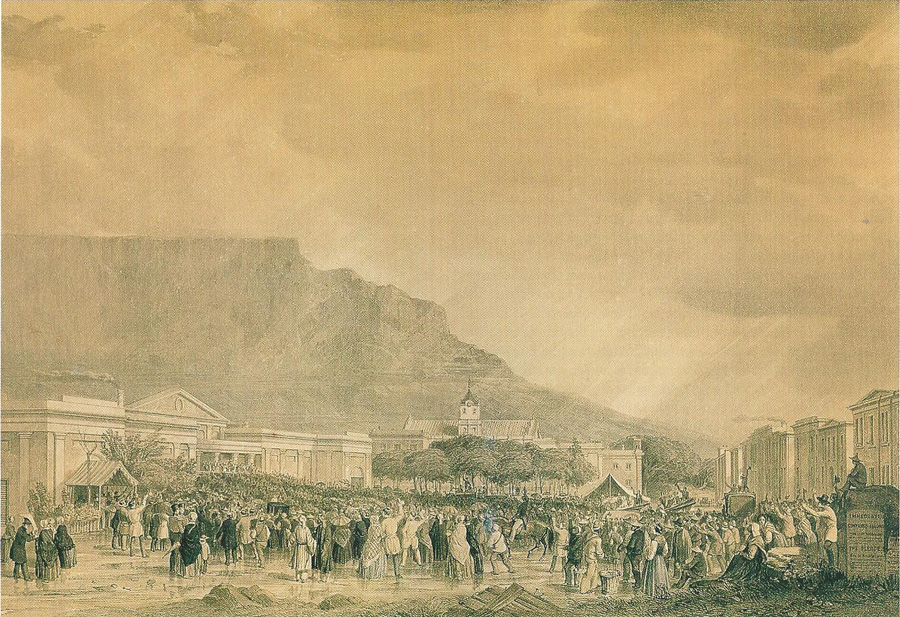
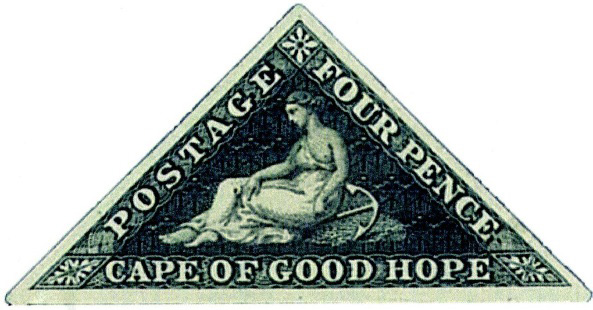
As mentioned the years 1849 and 1850 were significant ones for Charles Bell. After the anti-convict protests, his cousin was found to be unfit to hold office as a director of the Old Mutual, and Bell was appointed a director in his stead. He went on to become chairman of the Old Mutual in due course, and designed the famous emblem of Old Mutual, encompassing three anchors. Charles Bell divorced his wife in 1850 having had three children, and went on later to remarry.
Bell also had a love for heraldry as an art form, and this led him to become the designer of the famous Cape triangular stamp. He had been appointed as one of three men to a board of enquiry briefed to report on ‘the desirability or otherwise of the institution of prepayment of postage by means of stamps.’ The board reported that ‘in order to obviate errors in sorting letters so stamped, we would suggest the adoption of a device of size and shape so different from those of the English Postage Stamps as to catch the eye at a glance, and we would propose a Triangle, with a figure of “HOPE” in the centre with the words, ‘POSTAGE, FOUR PENCE, CAPE OF GOOD HOPE” on the surrounding border … as represented by the accompanying sketch of the Surveyor-General.’ The design was approved and Perkins, Bacon and Co in London were instructed to print 50 000 one penny and 100 000 four penny stamps. These stamps of classical beauty were issued on 1 September 1853.
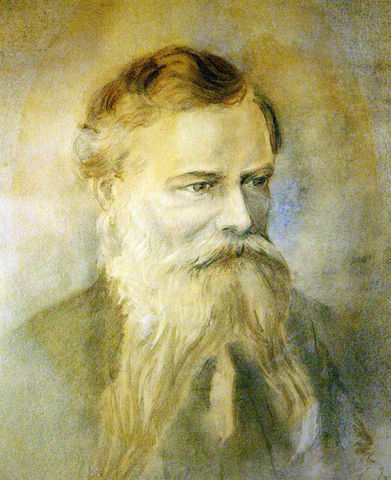 Biography
Biography
Bell was to spend another twenty years at the Cape and made a significant contribution in so many different ways. The suburb Bellville was named after him because of his work as engineer in the construction of the first railway line between Cape Town and Wellington, in 1859. It was said that he was the only one who could lay out railway curves, build bridges, raise embankments, bore tunnels, and inspect locomotives.
His greatest and most enduring contribution was his art, which is demonstrated by the use of different media ranging from watercolour and oils to lithographs and wood engravings, as well as book illustrations and heraldry designs. His artistic illustrations were prompted by his keen observations of life and landscapes on his extensive travels, and his figure studies of peoples encountered provide a fascinating contribution to the records of social life at the Cape and further afield in the 19th century.
Bell won a gold medal for the “Best original history painting” titled “The Landing of van Riebeeck at the Cape of Good Hope in 1652”, now held in the SA Library, Cape Town.
He returned to his native Scotland, in 1873. There he died in 1882, aged 68, leaving behind eight children as well as his great legacy of artwork, much of which is wonderfully preserved to this day by the John and Charles Bell Heritage Trust, housed at the University of Cape Town.




